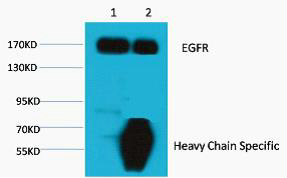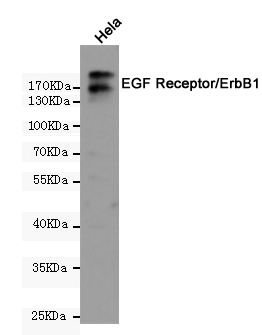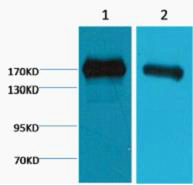-
Product Name
Anti-EGFR (5E9) Mouse antibody
- Documents
-
Description
EGFR (5E9) Mouse monoclonal antibody
-
Tested applications
WB, IP
-
Species reactivity
Human
-
Isotype
Mouse IgG1
-
Preparation
Antigen: Synthetic Peptide of EGFR
-
Clonality
Monoclonal
-
Formulation
PBS, pH 7.4, containing 0.02% sodium azide as Preservative and 50% Glycerol.
-
Storage instructions
Store at 4°C short term. Store at -20°C long term. Avoid freeze / thaw cycle.
-
Applications
WB: 1/1000-3000
-
Validations

1. Input: Hela Cell Lysate 2. IP product: IP dilute 1:200 Western blot analysis: primary antibody: 1:1,000 Secondary antibody: Goat anti-Mouse IgG, Heavy Chain Specific(S003), 1:5,000

Western blot detection of EGF Receptor/ErbB1 in Hela cell lysates using EGF Receptor/ErbB1 (5E9) Mouse mAb(1:1000 diluted).Predicted band size:170KDa.Observed band size:175KDa.

Western blot analysis of 1) A431, 2) Hela, diluted at 1:2000.
-
Background
Swiss-Prot Acc.P00533.Receptor tyrosine kinase binding ligands of the EGF family and activating several signaling cascades to convert extracellular cues into appropriate cellular responses. Known ligands include EGF, TGFA/TGF-alpha, amphiregulin, epigen/EPGN, BTC/betacellulin, epiregulin/EREG and HBEGF/heparin-binding EGF. Ligand binding triggers receptor homo- and/or heterodimerization and autophosphorylation on key cytoplasmic residues. The phosphorylated receptor recruits adapter proteins like GRB2 which in turn activates complex downstream signaling cascades. Activates at least 4 major downstream signaling cascades including the RAS-RAF-MEK-ERK, PI3 kinase-AKT, PLCgamma-PKC and STATs modules. May also activate the NF-kappa-B signaling cascade. Also directly phosphorylates other proteins like RGS16, activating its GTPase activity and probably coupling the EGF receptor signaling to the G protein-coupled receptor signaling. Also phosphorylates MUC1 and increases its interaction with SRC and CTNNB1/beta-catenin. Plays a role in enhancing learning and memory performance .
Related Products / Services
Please note: All products are "FOR RESEARCH USE ONLY AND ARE NOT INTENDED FOR DIAGNOSTIC OR THERAPEUTIC USE"
